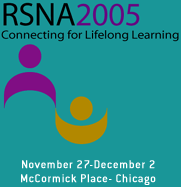
Abstract Archives of the RSNA, 2005
Barton F. Branstetter MD, Abstract Co-Author: Nothing to Disclose
Matthew B Morgan MD, Presenter: Nothing to Disclose
Chadd Nesbit MD,PhD, Abstract Co-Author: Nothing to Disclose
David M. Lionetti BA, Abstract Co-Author: Nothing to Disclose
Paul Joseph Chang MD, Abstract Co-Author: Nothing to Disclose
Jeffrey Dalton Towers MD, Abstract Co-Author: Nothing to Disclose
With the advent of PACS and paperless radiology departments, traditional preliminary interpretations from the emergency department (ED) can no longer be readily transmitted using paper requisitions. A new type of software, the preliminary report generator, is needed to distribute and document preliminary interpretations. The purpose of this study is to report the results of our 6-year experience with a preliminary report generator at a major academic medical center.
The study was performed at a large academic medical center that performs >1 million examinations per year. Our preliminary report generator allows preliminary interpretations to be attached directly to studies within the PACS, so that they can be reviewed by radiologists and clinicians at any PACS station. Each preliminary report is reviewed at the time of final interpretation and categorized as either “concordant” with the final reading, “minor discrepancy”, such as incidental findings, or “significant discrepancy”, such as finding that could immediately affect patient care. Ancillary information such as modality, radiology division, and training of preliminary author are also captured.
In the first six years after implementation, 591,934 examinations received preliminary reports. Of these, only 3207 cases (0.5%) were considered to have a “significant discrepancy” from the final reading. The number of preliminary reports rose entered into the system rose steadily over the six years, in part due to improved radiologist and clinician acceptance. Both radiologists and ED physicians have noted improved efficiency with the asynchronous communication mode of the preliminary report generator. Radiology quality assurance in the ED has become easy to perform because discrepant cases are automatically tracked. The user interface has been continually optimized over the six years that the system has been in place.
A deeply PACS-integrated preliminary report generator can improve communication and quality assurance in the ED. There are many critical design elements that make a prelinimary report generator more user-friendly and effective.
B.F.B.,M.B.M.,D.M.L.,P.J.C.: Laboratory support from Stentor, Inc.
Branstetter, B,
Morgan, M,
Nesbit, C,
Lionetti, D,
Chang, P,
Towers, J,
Preliminary Reports in the Emergency Department: A Six-Year Experience with a PACS-integrated Electronic Preliminary Report Generator. Radiological Society of North America 2005 Scientific Assembly and Annual Meeting, November 27 - December 2, 2005 ,Chicago IL.
http://archive.rsna.org/2005/4412890.html

